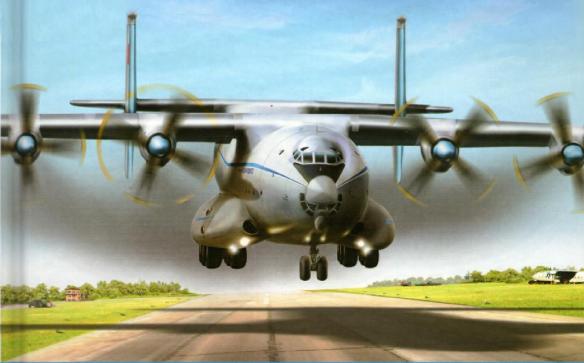The mighty Antei was once the world’s largest airplane and established several weight and altitude records that still stand. Despite its sheer bulk, it handles well and operates easily from unprepared airstrips.
Russia is characterized geographically by huge distances and varied topographical features that can make surface travel difficult, if not impossible. Air transportation is a possible solution, but this means that equipment must ferry huge quantities of cargo and supplies in order to be meaningful. In 1962 the Antonov design bureau was tasked with constructing a huge transport plane to facilitate the shuttling of military goods and services around the country and the world. In only three years, a functioning prototype emerged that stunned Western authorities when unveiled at the Paris Air Salon in 1965. The massive An 22 Antei (Antheus, after a huge son of Neptune in Greek mythology) was a well-conceived enlargement of the previous An 12. Like its predecessor, it was circular in cross-section and possessed wheel fairings under the fuselage. It also sports a capacious cargo hold and a pressurized crew and passenger cabin. To facilitate operations off wet and unprepared airstrips, pressurization of the six pairs of wheels is controllable from the flight deck and can be changed in midair to suit any landing surface. The secret to the An 22’s prodigious hauling ability is found in the trailing-edge flaps. These are designed to utilize the powerful prop wash flowing over the wing from the four contrarotating turboprop engines and provide added lift. Its military implications were obvious, and since 1969 an estimated 100 of the giant craft have been built and deployed. The NATO code name is COCK.
The An 22 was the world’s biggest airplane following its debut and established many useful world records. The only Soviet transport capable of freighting a T-72 tank, it was employed by the USSR as a propaganda machine during many “humanitarian” flights abroad.
After entering service, the An-22 set 14 payload to height records in 1967, the pinnacle of which was the airlift of 220,500 pounds (100 metric tonnes) of metal blocks to an altitude of 25,748 feet (7,848m). It also established the record for a maximum payload, 221,443 pounds (104,445kg), lifted to a height of 6,562 feet (2,000m). A number of speed records were also set in 1972, including a speed of 328 knots (608.5km/h) around a 540 nautical mile (1,000km) closed circuit with a 110,250 pound (50,000kg) payload. Several other speed-with-payload records were established in 1974 and 1975.
This giant reigned supreme until 1968, when an even larger craft, Lockheed’s C-5A Galaxy, premiered.
Variants
An-22
Prototypes built at Kiev-Svyatoshino with glass nose, three built.
An-22
Initial production variant with external start system, 37 built at Tashkent.
An-22A
Improved variant with air-start capability, modified electrical system, and updated radio and navigation equipment, 28 built at Tashkent.
An-22PZ
Conversion of two An-22s to carry wing centre sections or outer wings of Antonov An-124 or An-225 externally above fuselage. Fitted with third centreline fin.
LINK
Powerplants
Four 11,185kW (15,000shp) Kuznetsov (now Kuibyshev) NK12MA turboprops driving eight blade counter rotating propellers.
Performance
Max level speed 740km/h (400kt). Range with max fuel and 45 tonne (99,200lb) payload 10,950km (5905nm), range with max payload 5000km (2692nm).
Weights
Typical empty equipped 114,000kg (251,325lb), max takeoff 250,000kg (551,160lb).
Dimensions
Wing span 64.49m (211ft 4in), length 57.92m (190ft 0in), height 12.53m (41ft 1in). Wing area 345m2 (3713.0sq ft).
Capacity
Flightcrew of up to six, comprising two pilots, navigator, flight engineer and a communications specialist. Up to 29 passengers can be accommodated on the upper deck behind the cockpit. The unpressurised main cabin can house a range of oversize payloads such as main battle tanks. Total An-22 payload is 80,000kg (176,350lb).
Production
Approximately 70 have been built, of which approximately 50 have been operated in Aeroflot colours. A few dozen remain in commercial and military service.
